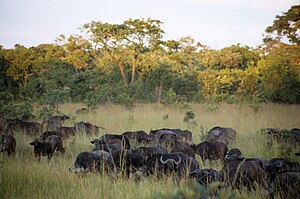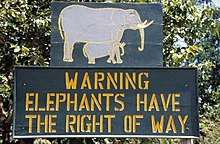Kasungu National Park
|
Kasungu National Park
|
|
|
Buffalo herd in Kasungu National Park |
|
| location | Malawi |
| surface | 2316 km² |
| WDPA ID | 780 |
| Geographical location | 13 ° 3 ' S , 33 ° 9' E |
| Setup date | 1970 |
The Kasungu National Park (English Kasungu National Park ), also written Kazungu National Park , is the second largest national park in Malawi with 2316 km² . It is located about 160 kilometers northwest of the capital Lilongwe on the border with Zambia and is named after the nearby city of Kasungu . The annual precipitation in the park varies between 750 and 1000 mm.
Landscape and vegetation
The park is 1000 to 1340 meters above sea level and is characterized by a diverse landscape. Dominant is the dense Miombo bush, which is characterized by individual, striking rocks or island mountains, especially in the central part and an imposing range of hills in the northeastern edge area on the border with Zambia. Over three-quarters of the park are plateaus, the rest are valleys along the east-west rivers such as Dwangwa and Lingadzi . The Kasungu National Park is crossed by several temporary rivers, which dry out almost completely in the dry season and form the so-called dambos , open grasslands along the rivers in their floodplain area . Centrally located is a more than 1 kilometer long dam on which the Lifupa Lodge , built in the 1970s, is located.
Forest of Brachystegia and Julbernardia species, including Julbernardia globiflora, grows on the plateau . Long filaments and myrobalans grow along the Dwangwa and some larger tributaries . Relatively dense hyparrhenia grassland borders the rivers in some places.
fauna
The animal population consists of the most prevalent in southern Africa species, including elephants , buffaloes , zebras and a wide variety of antelope such as roan , horse , cow and Eland and Greater Kudu , southern reedbuck , impala , ellipses waterbuck , duiker , Sharpe Greisbock and bleach-ram . In addition, live in the park warthogs , red river hogs , bears, baboons and vervet monkeys . Among the predators, the leopard , spotted hyena , striped jackal , serval and cheetah are represented. The bird population is estimated to be over 300 different species, including the rock crane .
Kasungu National Park was once famous for its abundance of game, especially for the huge herds of buffalo and elephant. The living conditions for elephants were ideal, especially in the center of the park. However, this picture has changed fundamentally since the 1980s; Due to the ongoing poaching, the population has decimated and elephants that left the park to the east were shot down because of damage to the land. Of the once up to 2000 elephants, 800 to 1000 were still alive in 1985 and only a good 50 in 2015. Black rhinoceros , lions and African wild dogs have been completely exterminated.
Nevertheless, the park still offers huge untouched wilderness areas and animals to be observed along the Dambos , especially in the dry season . Especially from August to December, when the rivers in the park dry up, many wild animals, especially elephants, can be seen right on the dam.
tourism
In the 1980s, Kasungu National Park had around 4,000 visitors a year. It offers around 120 kilometers of trails for animal observation and a landing strip for smaller aircraft near the administration. Tourism in the park is managed from the centrally located Lifupa Lodge . This has been under new management since 2005 and has been completely renovated since then. It is completely thatched and offers overnight accommodation, a bar and a restaurant . Overnight stays in comfortable 2- and 3-bed huts as well as in rustic bush huts and safari tents are offered. The latter are located on a separate campsite, which also offers a spacious lounge, kitchen and sanitary facilities. From Lifupa Lodge , safaris can be booked on foot or by car. As a special attraction, day fishing licenses can be purchased in Lifupa Dam .
history
Kasungu National Park offers some historical sights. Rock paintings in the Solonje hills and the remains of iron smelting furnaces in the north bear witness to the centuries-old settlement of the area.
In 1922, the area was used as a measure against tsetse flies for Forest Reserve ( forest reserve declared). It received the status of a game reserve in 1930 and in 1970 it was declared a national park. A buffer zone of around 160 km² on the south-eastern park boundary was set up in 1977 and provided with an 8-kilometer-long solar-powered electric fence. Nevertheless, there are always conflicts between animals migrating from the national park and small farmers who grow tobacco nearby.
In 2004, a contract was signed between Malawi and neighboring Zambia to set up a cross-border protected area. The formal implementation followed in 2015. Together with the Lukusuzi National Park in Zambia and a corridor without protection status in between, the Kasungu National Park now forms a cross-border protected area within the framework of the Peace Parks . Joint measures against poaching are being undertaken with financial support from GIZ and the Peace Parks Foundation .
literature
- Wally and Horst Hagen: The African national parks as habitats for elephants . In: Vitus B. Dröscher (Ed.): Save the elephants of Africa . 1st edition. Goldmann Verlag , Munich 1992, ISBN 3-442-12322-4 , p. 257 .
Web links
- Kasungu National Park. In: AfricaGuide.com. Retrieved November 5, 2019 .
- Kasungu National Park. ( Memento of June 17, 2006 in the Internet Archive ) Editor: WCMC (English).
- Kasungu National Park. In: All About Malawi. Retrieved November 5, 2019 .
- Kasungu-Lukusuzi. In: Peace Parks Foundation . Retrieved November 5, 2019 .



